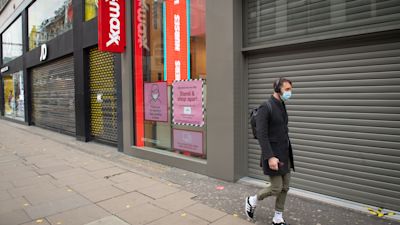Nearly 60% of newly unemployed are under-25, official data shows

Unemployment levels in the UK have risen again, with under-25s among the hardest hit, latest data shows.
Office for National Statistics (ONS) figures from January 2021 show there are 726,000 fewer people in payrolled unemployment compared with February 2020. Of those unemployed, 425,000 (58.5%) were under 25-years-old.
The unemployment rate also reached 5.1% between October and December last year - the highest figure in five years. The last time the unemployment rate was above 5% was in the autumn of 2015.
Although the ONS said there were signs the job market was stabilising and the number of payrolled workers rose by 83,000 between January and February in the second small monthly increase in a row.
Jonathan Athow, deputy national statistician at the ONS, said: “The latest monthly tax figures show tentative early signs of the labour market stabilising, with a small increase in the numbers of employees paid through payroll over the last couple of months – though there are still over 700,000 fewer people employed than before the start of the coronavirus pandemic."
Mr Athow said the rise in unemployment was the highest since the financial crisis and had hit the young the hardest.
Almost 60% of the people who had lost their jobs since the start of the pandemic were under-25s.
Chancellor Rishi Sunak, reacting to the latest unemployment figures, said: “I know how incredibly tough the past year has been for everyone, and every job lost is a personal tragedy.
“That’s why throughout the crisis, my focus has been on doing everything we can to protect jobs and livelihoods.
“At the Budget next week I will set out the next stage of our Plan for Jobs, and the support we’ll provide through the remainder of the pandemic and our recovery.”
The furlough scheme has been helping cushion some of the blow of the pandemic, though there are fears of a spike in unemployment when it comes to an end.
Wedding organiser says industry is on its knees due to restrictions
The ONS also said the number of job vacancies available was also recovering but was still far lower than before the pandemic.
The pandemic has rocked the economy in ways previously thought unimaginable and has led to the biggest contraction since the 1920s.
Since the start of the pandemic GDP has dropped by almost 10% although this has been recovering slightly in recent months, despite harsh restrictions.
There is no data available yet for January when the country was plunged back into full lockdown.
On Monday Prime Minister Boris Johnson revealed England's roadmap out of lockdown, which he said he hoped would be the final lockdown.
There are hopes almost all restrictions on business and social distancing can be lifted by June 21 but some in the hospitality sector have warned they cannot wait that long.
During a visit to a school in south London Mr Johnson said on Tuesday there were the economy was changing naturally but the government would continue to "put our arms around everybody” during the pandemic.
Total wages rose by 4.7% annually over the quarter to December, thanks to end of year bonuses, but the ONS stressed that, with a high proportion of jobs axed being lower-paid roles, the underlying increase is likely to be around 3%.
The Bank of England is forecasting the jobless rate to surge to almost 8% by the middle of 2021, however Mr Sunak is expected to announce an extension of job support in the March 3 Budget.
Economist James Smith, at ING, said: “The latest UK jobs data provides further evidence that the jobs market stabilised in the final weeks of 2020, following a turbulent autumn.”
But he cautioned: “We suspect that the unemployment rate will rise to around 6-6.5% through the middle of the year, and potentially higher if wage support is removed fairly abruptly in the second quarter.”